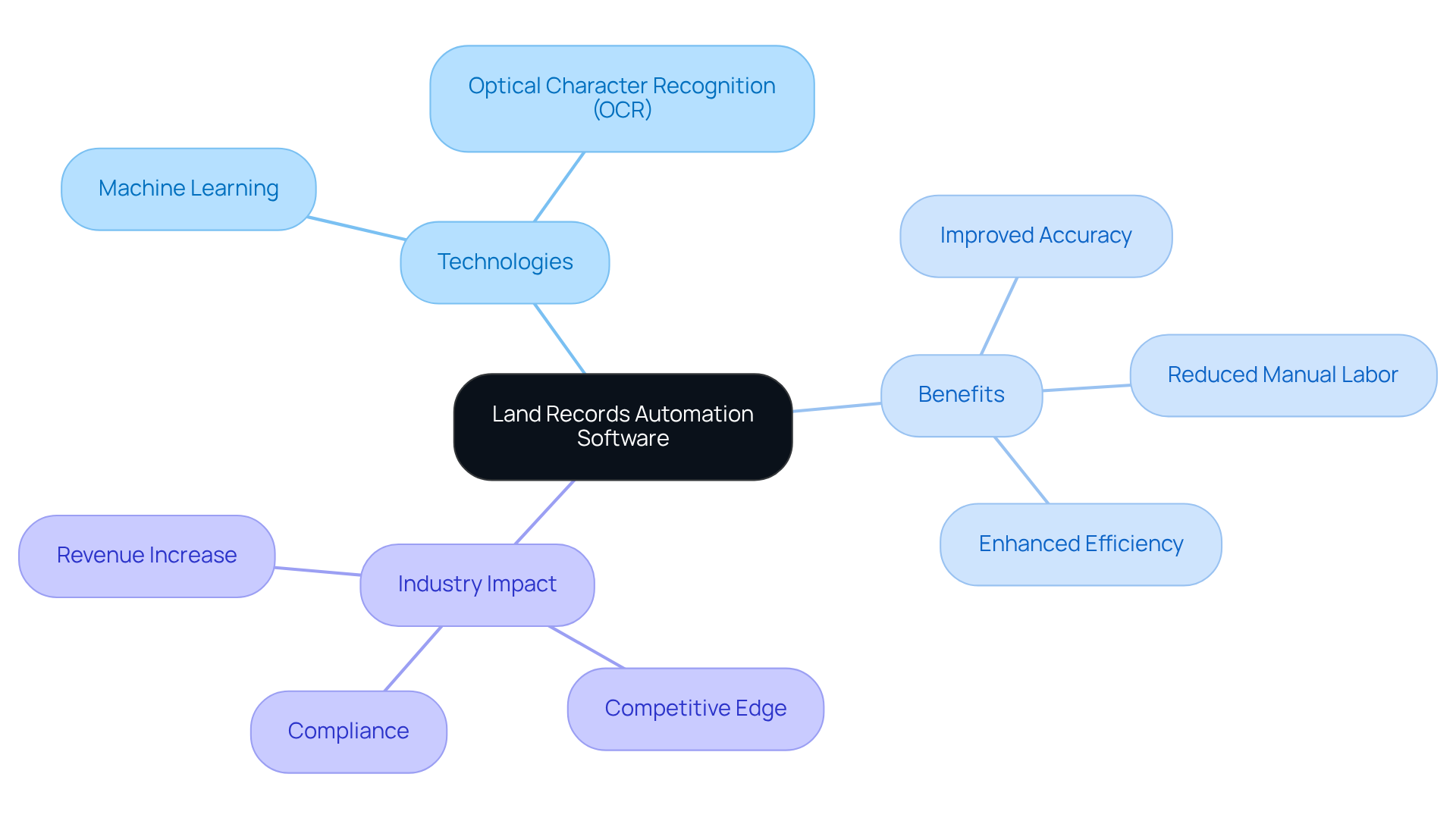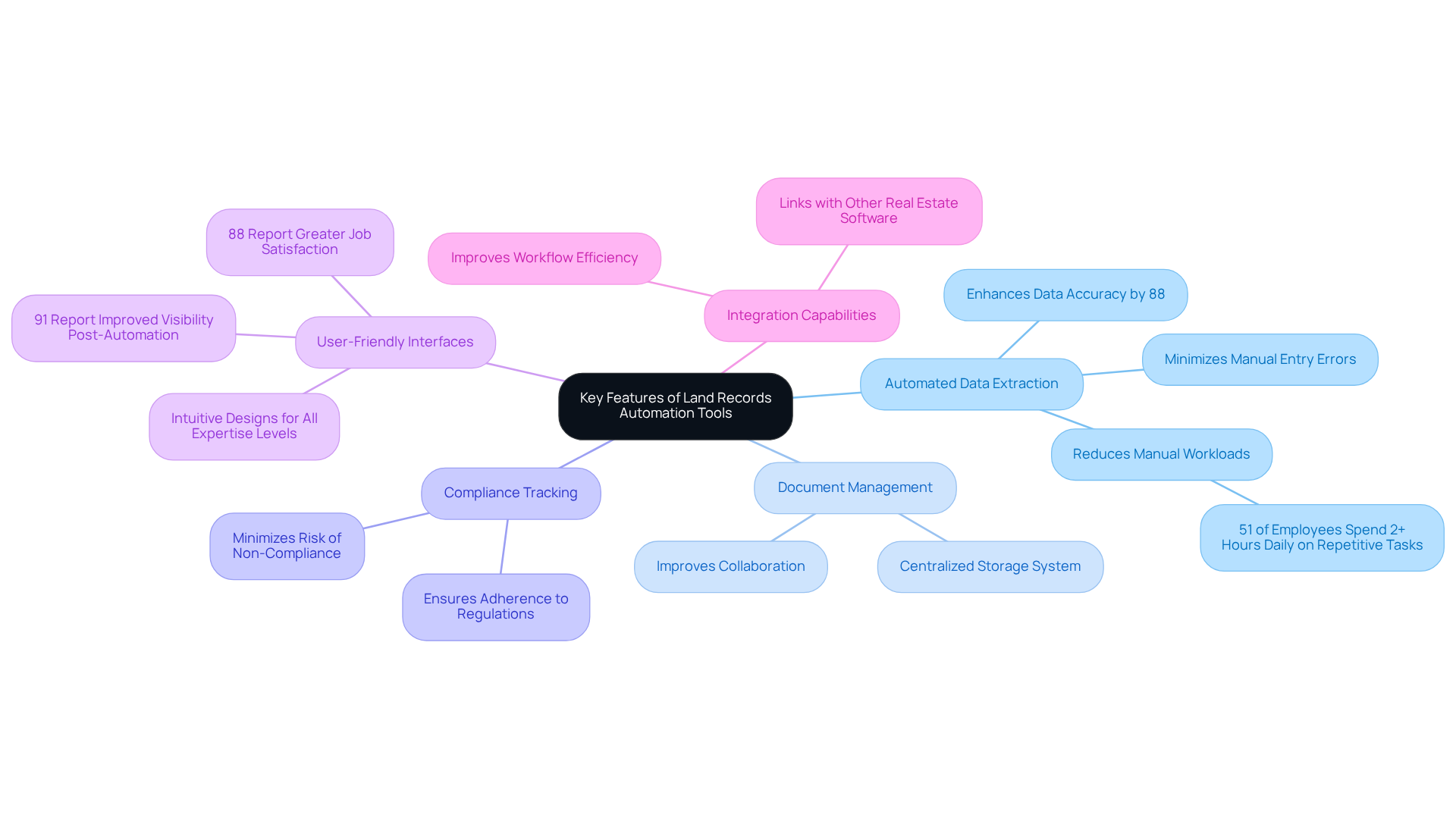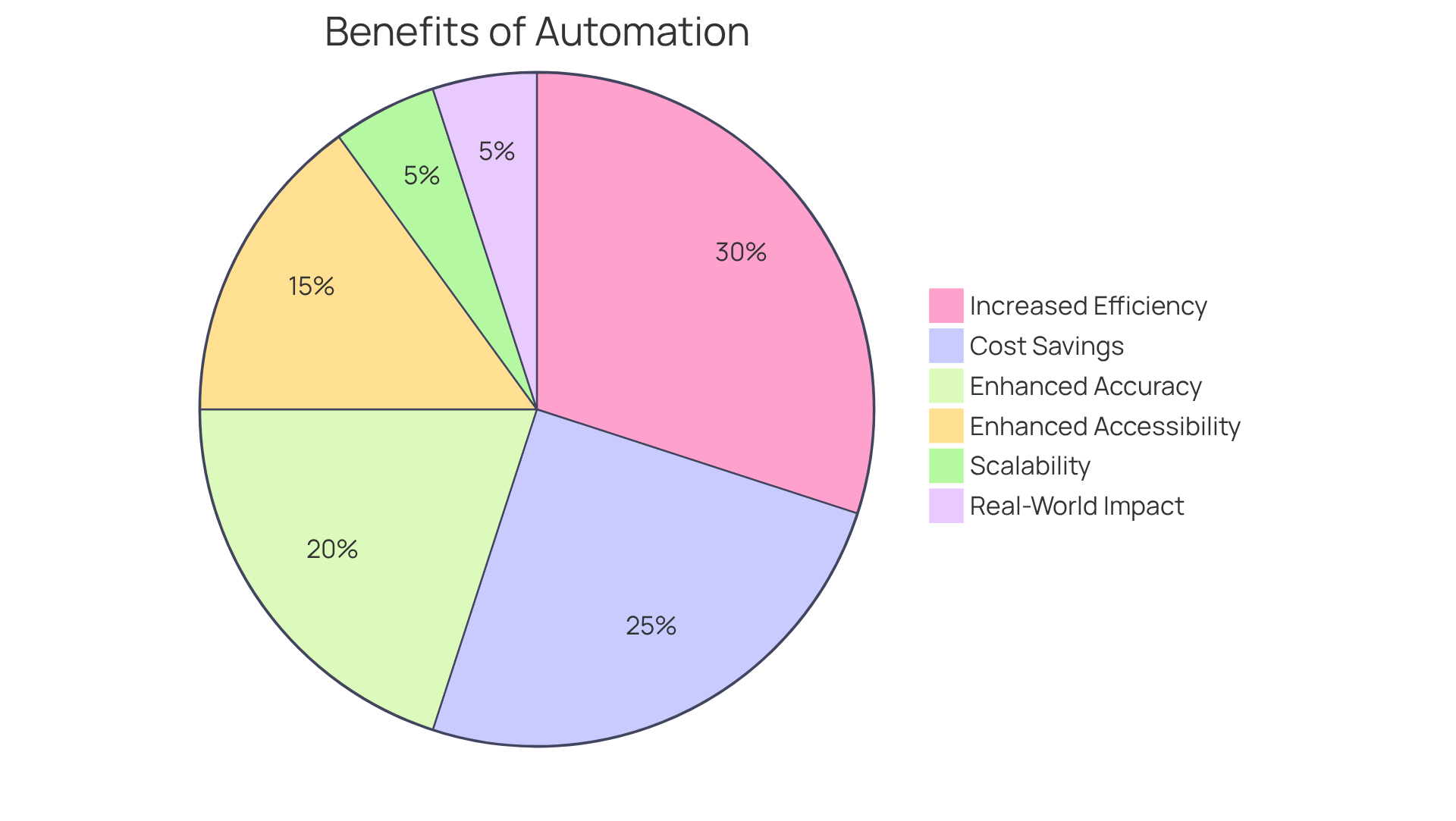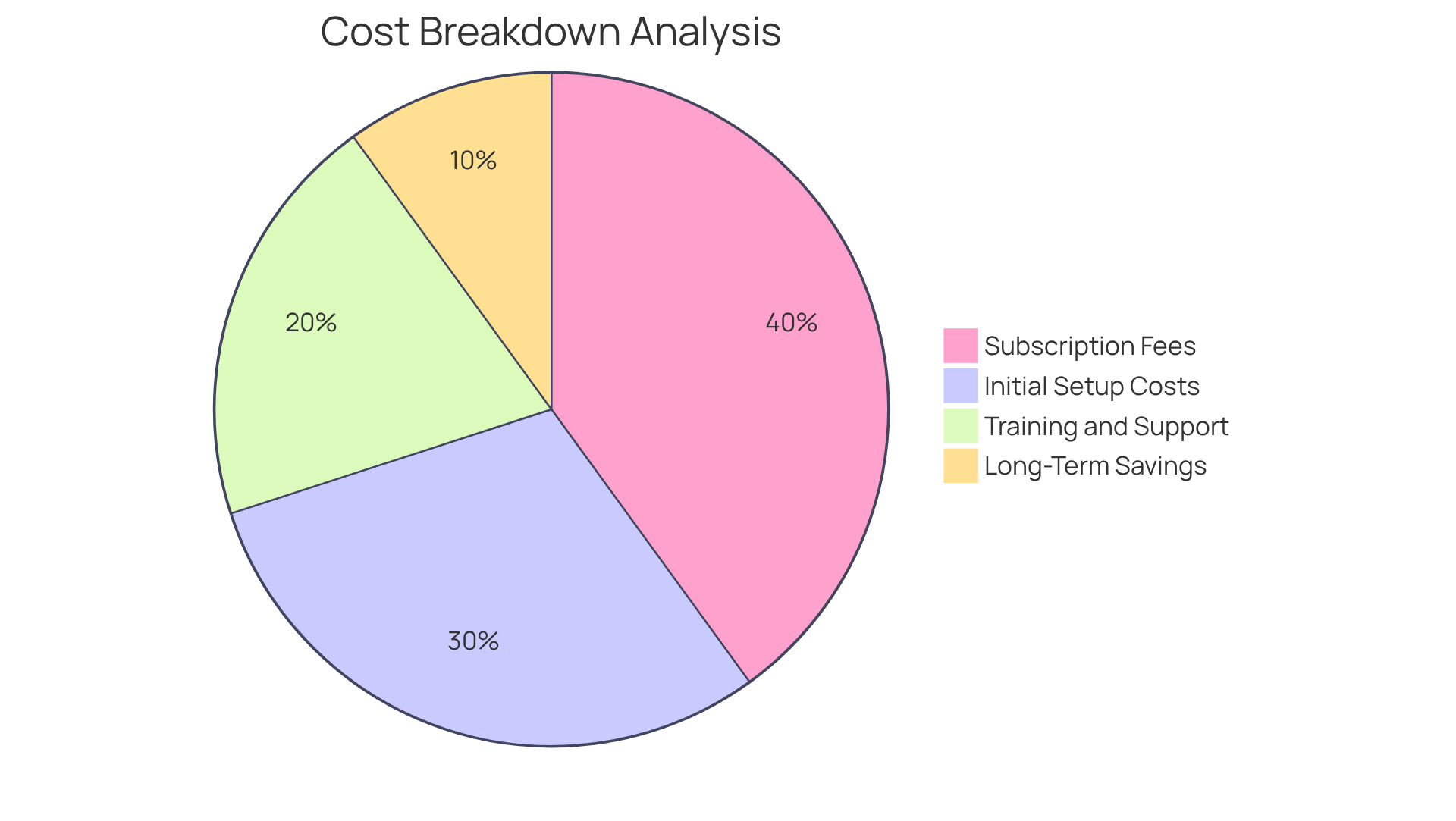Overview
This article examines the best land records automation software for 2025, highlighting its critical role in enhancing efficiency, accuracy, and compliance within real estate operations. The discussion begins with the significance of automating land records, addressing the challenges faced in traditional methods. Key features such as:
- Automated data extraction
- Document management
- Compliance tracking
are detailed, illustrating how these elements collectively minimize manual labor and reduce errors. Consequently, this leads to substantial cost savings and improved operational effectiveness for real estate professionals, fostering a more streamlined and reliable workflow.
Introduction
As the landscape of real estate continues to evolve, the implementation of land records automation software has become increasingly vital for professionals in the industry. These innovative tools not only streamline the management of property information but also enhance accuracy and efficiency, allowing organizations to thrive in a competitive market.
However, with numerous options available, how can one determine which software truly stands out in terms of features, cost, and overall value? This article delves into a comparative analysis of the best land records automation software for 2025, providing insights that can help real estate professionals make informed decisions and elevate their operational capabilities.
Understanding Land Records Automation Software
The best land records automation software is crucial in streamlining the handling of property information, enabling real estate professionals to confidently verify ownership and facilitate transactions. By harnessing advanced technologies such as machine learning and optical character recognition (OCR), these tools automate the extraction and processing of data from title documents. The use of the best land records automation software for digitization and organization of land records significantly improves accuracy, reduces manual labor, and enhances overall efficiency in land administration.
As the real estate sector evolves, the adoption of the best land records automation software is not merely advantageous but essential for maintaining a competitive edge and ensuring compliance with legal standards. Notably, 63% of businesses report revenue increases following the adoption of AI technologies, highlighting the transformative impact of these innovations in property management. Real estate experts increasingly recognize that incorporating mechanization into their workflows is vital for optimizing operations and meeting the demands of a rapidly changing market.

Key Features of Land Records Automation Tools
Key features of land records automation tools are essential for enhancing efficiency and accuracy in real estate operations:
-
Automated Data Extraction: Leveraging advanced optical character recognition (OCR) technology, these tools significantly minimize manual entry errors by swiftly extracting relevant information from title documents. This capability not only streamlines the data entry process but also enhances overall data accuracy by up to 88%. Furthermore, with 51% of employees dedicating at least two hours each day to repetitive tasks, automated tools play an essential role in decreasing manual workloads.
-
Document Management: The best land records automation software offers a centralized storage system that enables easy access and retrieval of land records, ensuring that all stakeholders can quickly locate necessary documents. This feature is crucial for maintaining operational efficiency and improving collaboration among team members.
-
Compliance Tracking: The best land records automation software equipped with compliance tracking functionalities helps ensure adherence to local regulations and legal requirements. Consequently, this minimizes the risk of non-compliance, which can lead to costly penalties and delays in property transactions.
-
User-Friendly Interfaces: The best land records automation software offers intuitive designs that cater to professionals with varying levels of technical expertise, facilitating ease of use. This is particularly important as 91% of businesses report improved visibility into processes post-automation, indicating that user satisfaction is closely tied to interface design. Moreover, 88% of employees indicate greater job satisfaction and reduced stress due to the best land records automation software, further highlighting its beneficial effects.
-
Integration Capabilities: The best land records automation software provides the ability to effortlessly link with other real estate software systems, such as CRM, ERP, and project coordination systems, improving workflow efficiency and data sharing. This integration is vital as it allows for a more cohesive operational environment, reducing the time spent on manual data transfers and improving overall productivity.
As the implementation of technology in real estate continues to grow, with 75% of top U.S. brokerages incorporating AI innovations, these aspects will significantly influence the future of property documentation. For example, AI-enhanced property marketplaces can connect buyers to properties with 95% precision, demonstrating the real-world use and efficiency of these technology tools.

Benefits of Implementing Automation in Land Records Management
Implementing automation in land records management presents a range of significant benefits:
-
Increased Efficiency: Automation can accelerate the processing and verification of land records, enabling professionals to dedicate more time to strategic, high-value tasks. Organizations that implement the best land records automation software can achieve processing speeds up to 85 times faster than traditional methods.
-
Cost Savings: By reducing manual labor and minimizing errors, businesses can achieve substantial operational cost reductions. Statistics suggest that automating financial processes can save organizations 30-40% of the time devoted to tasks, resulting in considerable savings in title research and document organization.
-
Enhanced Accuracy: Automated systems drastically lower the risk of human error, resulting in more reliable data and fewer disputes regarding property ownership. This improvement in accuracy can reduce reporting errors by up to 90%, fostering trust among stakeholders.
-
Enhanced Accessibility: Digital files permit remote access, promoting collaboration among different stakeholders and accelerating transactions. This accessibility is crucial in today’s fast-paced real estate environment, where timely information is essential.
-
Scalability: As organizations expand, automated systems can seamlessly adapt to increased data volumes without necessitating a proportional rise in staffing. This scalability is vital for maintaining efficiency as business demands grow.
-
Real-World Impact: Case studies demonstrate the efficiency of mechanization in property documentation. Organizations that have implemented automated title research tools report significant cost savings and enhanced operational efficiency, allowing them to manage larger volumes of transactions with greater ease.
In conclusion, the incorporation of the best land records automation software in property documentation simplifies procedures while providing significant financial benefits and operational enhancements, establishing it as a crucial approach for real estate experts.

Cost Analysis of Leading Land Records Automation Software
When assessing the costs associated with leading land records automation software, several critical factors warrant careful consideration:
-
Initial Setup Costs: This encompasses software licensing fees, installation expenses, and any necessary hardware upgrades. These costs can vary significantly based on the complexity of the system and the specific requirements of the organization.
-
Subscription Fees: Many software solutions operate on a subscription model, with monthly or annual fees that fluctuate according to the number of users and the features included. For instance, basic plans can start as low as $0 to $50, while advanced plans may reach up to $500 or more, depending on the functionalities offered.
-
Training and Support: It is essential to include the costs associated with training staff to effectively utilize the new system, as well as ongoing technical support. This investment is crucial for maximizing the software's potential and ensuring a smooth transition.
-
Long-Term Savings: Although initial costs may seem substantial, the long-term savings derived from enhanced efficiency and reduced errors can significantly offset these expenses. Organizations can expect to save on labor costs and improve transaction speeds, leading to faster revenue generation. For instance, utilizing property oversight software can save teams between 240 to 480 hours annually, resulting in significant productivity improvements, as highlighted in case studies on the ROI of Property Oversight Software.
A comparative analysis of specific software options, such as Parse AI, Tyler Technologies, and GovOS, reveals insights into which solution offers the best land records automation software for the best value for money based on features and organizational needs. As the land management software market is projected to grow from $2 billion in 2024 to $2.14 billion in 2025, understanding these cost dynamics is essential for making informed decisions.

Conclusion
The significance of adopting the best land records automation software cannot be overstated; it plays a pivotal role in enhancing the efficiency and accuracy of property management. Embracing these advanced tools is essential for real estate professionals who aim to streamline operations, reduce manual errors, and ultimately gain a competitive edge in the evolving market landscape.
Key features such as:
- Automated data extraction
- Document management
- Compliance tracking
- User-friendly interfaces
have been highlighted as critical components contributing to the effectiveness of land records automation tools. Furthermore, the considerable benefits of implementing such systems—ranging from increased efficiency and cost savings to enhanced accuracy and scalability—underscore the transformative potential these technologies hold for the real estate sector.
In light of these insights, it is clear that investing in land records automation software is not merely a trend but a necessary step for organizations striving to optimize their operations. As the market continues to grow and evolve, real estate professionals are called to action: prioritize the integration of these innovative solutions into their workflows. This ensures they remain at the forefront of industry advancements and capable of meeting the demands of a fast-paced environment.
Frequently Asked Questions
What is land records automation software?
Land records automation software is a tool designed to streamline the handling of property information, enabling real estate professionals to verify ownership and facilitate transactions efficiently.
How does land records automation software improve accuracy?
It utilizes advanced technologies such as machine learning and optical character recognition (OCR) to automate the extraction and processing of data from title documents, significantly enhancing accuracy.
What are the benefits of using land records automation software?
The software reduces manual labor, improves overall efficiency in land administration, and helps in the digitization and organization of land records.
Why is adopting land records automation software essential for real estate professionals?
As the real estate sector evolves, using this software is essential for maintaining a competitive edge, ensuring compliance with legal standards, and optimizing operations in a rapidly changing market.
What impact does adopting AI technologies have on businesses in the real estate sector?
Notably, 63% of businesses report revenue increases following the adoption of AI technologies, indicating a transformative impact on property management.
How are real estate experts responding to the need for automation?
Real estate experts increasingly recognize the importance of incorporating mechanization into their workflows to meet the demands of the evolving market.




